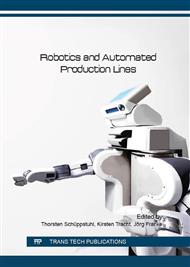[1]
ISO 8373, Robots and robotic devices – Vocabulary. (2012).
Google Scholar
[2]
S. Kristensen, M. Neumann, S. Horstmann, F. Lohnert, A. Stopp, A., Tactile Man-Robot Interaction for an Industrial Service Robot, in: Sensor Based Intelligent Robots, H.I. Christensen, and G. Hager (editors), Lecture Notes in Artificial Intelligence, Springer. (September 2001).
DOI: 10.1007/3-540-45993-6_11
Google Scholar
[3]
P. Plöger, K. Pervölz, C. Mies, P. Eyerich, M. Brenner, B. Nebel, The DESIRE Service Robotics Initiative, Künstliche Intelligenz - KI, Vol. 22, No. 4, (2008) 29-32.
Google Scholar
[4]
S. Cambon, R. Alami, F. Gravot, A hybrid approach to intricate motion, manipulation and task planning, The International Journal of Robotics Research, vol. 28, no. 1, (2009) 104–126.
DOI: 10.1177/0278364908097884
Google Scholar
[5]
M.R. Pedersen, V. Krüger. Automated Planning of Industrial Logistics on a Skill-equipped Robot, IROS 2015 workshop Task Planning for Intelligent Robots in Service and Manufacturing, Hamburg, Germany. (October 2015).
Google Scholar
[6]
H. Mosemann, F. Wahl, Automatic decomposition of planned assembly sequences into skill primitives, IEEE Transactions on Robotics and Automation, vol. 17, (October 2001), 709 –718.
DOI: 10.1109/70.964670
Google Scholar
[7]
J. T. C. Tan, F. Duan, R. Kato, T. Arai, Collaboration Planning by Task Analysis, in Human-Robot Collaborative Manufacturing System, Advances in Robot Manipulators, Ernest Hall (Ed. ), ISBN: 978-953-307-070-4, InTech. (2010).
DOI: 10.5772/9543
Google Scholar
[8]
K. Beumelburg, Fähigkeitsorientierte Montageablaufplanung in der direkten Mensch-Roboter-Kooperation, Heimsheim, Jost-Jetter-Verlag. (2005).
Google Scholar
[9]
DIN EN ISO 10218, Robots and robotic devices - Safety requirements for industrial robots - Part 1: Robots. (2012).
DOI: 10.3403/30218711
Google Scholar
[10]
C. Thomas, F. Busch, B. Kuhlenkötter, J. Deuse, Ensuring Human Safety with Offline Simulation and Real-time Workspace Surveillance to Develop a Hybrid Robot Assistance System for Welding of Assemblies, Proceedings of the 4th International Conference on Changeable, Agile, Reconfigurable and Virtual Production (CARV2011) (Montreal, Canada), (2011).
DOI: 10.1007/978-3-642-23860-4_76
Google Scholar
[11]
C. Thomas, M. Klöckner, B. Kuhlenkötter, Mensch-Roboter-Kollaboration – Von der industriellen Produktion bis zum Anwendungsgebiet Rehabilitation, Erste transdisziplinäre Konferenz zum Thema Technische Unterstützungssysteme, die die Menschen wirklich wollen, (2014).
Google Scholar
[12]
J. Deuse, J. Rossmann, B. Kuhlenkötter, A. Hengstebeck, O. Stern, M. Klöckner, A Methodology for the Planning and Implementation of Service Robotics in Industrial Work Processes, Proceedings of the 5th CATS 2014 CIRP Conference on Assembly Systems and Technologies, 23, (2014).
DOI: 10.1016/j.procir.2014.10.066
Google Scholar
[13]
A. Hengstebeck, K. Weisner, M. Klöckner, J. Deuse, B. Kuhlenkötter, J. Roßmann, Formal modelling of manual work processes for the application of industrial service robotics, Proceedings of 48th CIRP Conference on Manufacturing Systems (CMS 2015), Naples, Italy. (2015).
DOI: 10.1016/j.procir.2015.12.013
Google Scholar
[14]
M. Fox, D. Long, An Extension to PDDL for Expressing Temporal Planning Domains (PDDL2. 1), Journal of Artificial Intelligence Research, Vol. 20, No. 20, AI Access Foundation, (2003) 61-124.
DOI: 10.1613/jair.1129
Google Scholar
[15]
J. Rossmann, M. Schluse, A Foundation for e-Robotics in Space, in Industry – And in the Woods, Proceedings of the 4th International Conference on Developments in eSystems Engineering, (2011) 496-501.
Google Scholar
[16]
J. Rossmann, E. Kaigom, L. Atorf, M. Rast, G. Grinshpun, C. Schlette, Mental Models for Intelligent Systems: eRobotics Enables New Approach to Simulation-Based AI, KI – Künstliche Intelligenz 2. No. 2 (June), (2014) 101-110.
DOI: 10.1007/s13218-014-0298-z
Google Scholar
[17]
J. Rossmann, C. Schlette, The Simulation and Animation of Virtual Humans to Better Understand Ergonomic Conditions at Manual Workplaces, The Journal on Systemics, Cybernetics and Informatics (JSCI), Volume 8. (2010).
Google Scholar
[18]
N. Wantia, D. Losch, J. Rossmann, Symbolic Planning for Industrial Applications – the eRobotics Approach, Proceedings of the IEEE International Conference on Automation Science and Engineering (CASE), IEEE, ISBN 978-1-4799-5283-0. (2014).
DOI: 10.1109/coase.2014.6899352
Google Scholar
[19]
F. Heinze, F. Wolf, K. Weisner, J. Rossmann, J. Deuse, B. Kuhlenkoetter, Motion Capturing for the Simulation of Manual Industrial Processes, Proceedings of the 13th ISC, No. 13, Valencia, Spain, (2015) 48-52.
Google Scholar


